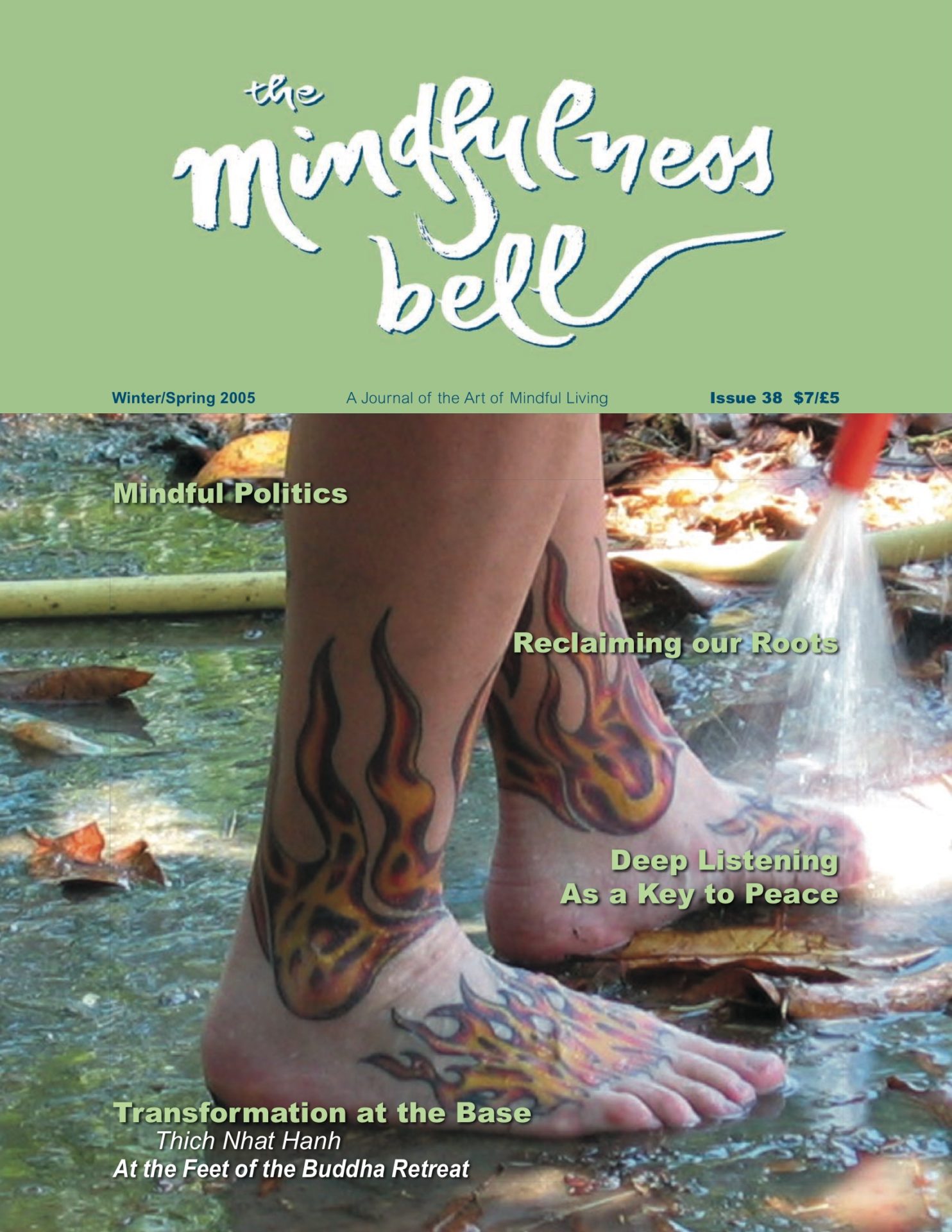From a Dharma Talk by Thay Phap An
June 13, 2004
Upper Hamlet, Plum Village
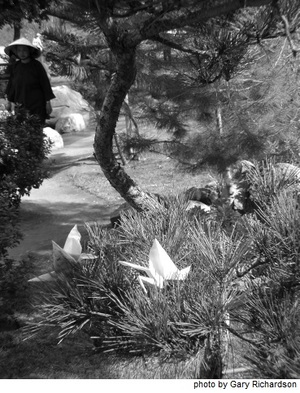
Respected Thay, respected brothers and sisters, and the whole community: Today is June 13th, 2004. We are in Dharma Cloud Temple in the Upper Hamlet.
In the last two weeks, we have learned that we can depict our consciousness as a circle with two parts. The lower part is called store consciousness,
From a Dharma Talk by Thay Phap An
June 13, 2004
Upper Hamlet, Plum Village

Respected Thay, respected brothers and sisters, and the whole community: Today is June 13th, 2004. We are in Dharma Cloud Temple in the Upper Hamlet.
In the last two weeks, we have learned that we can depict our consciousness as a circle with two parts. The lower part is called store consciousness, and the upper part is the mind consciousness. In our store consciousness there are many seeds––seeds of joy, seeds of happiness, and seeds of tolerance. But there are also seeds of anger, of frustration, and of jealousy. Our practice is to water the positive seeds so they will manifest and try our best not to invite the negative seeds to come up into our mind consciousness.
The Early Days at Plum Village
When I first came to Plum Village I had many ideas about the practice. I had ideas about the Buddha from books I had read. I had ideas about how a teacher should be and ideas about what monks and nuns should be like. At first, the Sangha was very small. There were only four monks, and there was a lot of work. My perception was that life in Plum Village was not well organized, so I volunteered to be the work coordinator, and I worked very hard, trying my best to organize Plum Village.
I had the idea that my teacher should be available to me, giving me affection when I needed it, and spending a lot of time talking with me. One time in 1993, when I had been a monk for about a year and a half, I went to America to lead a retreat. I missed Thay a lot and I hoped that when I saw Thay again, he would ask me, “How are you doing? Are you doing fine?”
Upon my return, Thay visited the Upper Hamlet, and he walked by the temple office where I was standing, waiting patiently to see him. I joined my palms and bowed to Thay sincerely and with respect, and Thay continued his practice of walking meditation. He didn’t even look at me! And I felt very sad. I said to myself, “Well, it seems that Thay doesn’t have any sense about the student-teacher relationship.” [Laughter.] “He doesn’t seem to look at me at all; he just continues walking and disregards his student.” At that time most of us were new to the practice, so our understanding was still very weak.
I had so many ideas about how monks should be. When an elder brother would do something different from my expectation, I would feel sad and want to leave Plum Village. The seed of wanting to run away is very strong within me. Thay used to call me Hungry Ghost, because I have a very big seed of hungry ghost within my consciousness. Growing up in America, I was trained to be judgmental and critical.
Often we do not have much opportunity to touch the goodness and beauty that is around us. When our practice is weak, we continue to allow the seeds of frustration, anger, and judgment to come up from our store consciousness into the mind consciousness. And if our mindfulness is weak, we allow ourselves to be carried away by those energies.
Learning to Speak the Truth
In the summer of 1994 I made a big mistake while preparing for the great ordination ceremony. I was the work coordinator, and it was a difficult job because the Sangha was small and we had to do all the cooking, and we also had to be attendants for many elder monks and nuns who were coming for the ceremonies.
There was one elder brother who had been a monk for many years. He had studied in India and then went to Holland; gradually he left his path as a monk. But that spring he had come to Plum Village and was to be ordained as a monk again. I respected him a lot, but I also had a lot of ideas about him.
During our planning meeting he volunteered to organize the Full Moon Festival. I was very happy, because it is difficult to find someone to do this during the summer retreat. But the next day as I was washing my dish, he came up and said, “Well, I’m not going to organize the Full Moon Festival because the monk who did it last year refused to help me by passing on his experience.”
I said, “ What?! You promised that you would organize the Full Moon Festival, and now you won’t do it? How can you do that to me? Everyone already has jobs, so who’s going to organize the festival? Nobody can do it. Will you please do it?”
But he refused again.
A few days later, under the linden tree, we had a Sangha meeting to water the positive seeds within ourselves before the retreat. Thay gave a good talk, watering the flowers of everyone in the Sangha. Then he asked, “Are there any questions?”
I raised my hand and said, “Yes, I have a question.” I stood up and asked, “How can we organize a summer retreat when someone here refuses to take the responsibility of doing his work?” [Laughter.] Right in front of the Sangha, I continued explaining and complaining.
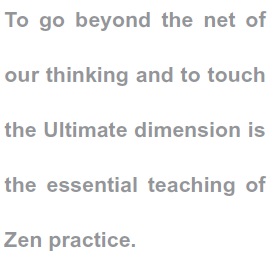
In this meeting, Thay had tried his best to bring all of the good seeds from our store consciousness up to our mind consciousness, and then I turned around and invited all the negative seeds up. The whole Sangha became very tense.
Thay was not very happy. He said, “Sit down and shut up!” [Laughter.]
I was very upset because I thought I was only speaking the truth and had asked for help. I didn’t realize that I had watered the negative seeds in everyone’s consciousness. When the meeting was over, I went and bowed to Thay and said, “Thay, please forgive me. I have made a mistake, but I don’t understand what I did, because I was only speaking the truth.”
Thay said, “What you spoke was not the truth. Truth is something that has the capacity to reconcile, to give people hope, to give people happiness. That is truth! When you speak and it causes damage, even though it may be correct, it is not truth.”
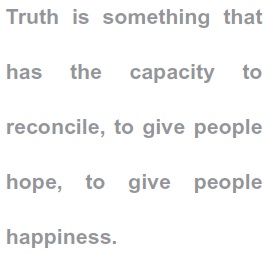
I come from America, where we are taught that we should be honest, direct, and straightforward. So if I don’t like something, I want to say it directly. But sometimes you need to use skillful means to speak, and that skill for me is truth. Truth has the capacity to reconcile, has the capacity to bring harmony and peace.
Slowly I began to learn that some of my perceptions were not in accord with the practice. I needed to learn new ways of perceiving. I needed to learn to look at things positively.
The Secret of Plum Village Practice
Many people come to Thay and talk about issues that come up in the community, and they are earnestly looking for answers from Thay. But being a Zen master, usually Thay doesn’t respond directly. Instead he helps that person to return to his or her practice, to touch what is beautiful in that moment. And that is the secret of the practice of Plum Village.
If we do not have happiness within ourselves, if we do not have peace within ourselves, whatever we do is only a reaction. Action is based on joy and happiness; reaction is based on suffering and pain. Slowly I learned to act, and not to react.
Many times I have said, “Well, Thay only talks about breathing in, breathing out, year after year––water the good seeds––he has nothing new to talk about with us!”
But after five years of listening to Thay’s Dharma talks, I understood what he meant when he said that life is a miracle and it’s possible to touch joy and happiness in the here and now. It’s possible to see the beauty of the blue sky, and to be able to have deep joy in the present moment.
In every single retreat Thay tells us that when we walk, we should not talk. And when we talk, we should stop and be truly present to each other. But as soon as we leave the Dharma hall, we continue walking and talking at the same time. So we listen only with our ears, not with our heart. And we are not able to really practice.
When I have a problem, when I have sadness, I approach Thay. He listens to me, then takes my hand and we walk into the garden. He points out the beauty: “Hear the sound of the creek, see the bamboo, the blue sky, the flower.” To go beyond the net of our thinking and to touch the Ultimate dimension is the essential teaching of Zen practice. To touch life deeply in the here and now. When Thay teaches us about the Four Noble Truths, he first teaches us to water our positive seeds, to get in touch with the positive element around us. He teaches that it is possible to be happy in the here and now, regardless of how much suffering we have. And then, once we are strong enough, that tiny bit of happiness and joy is the ground on which we will stand when we begin to look into the big block of suffering that’s in our store consciousness. Without this ground of happiness and joy, it’s very difficult to touch our suffering. Without it, we will be carried away by our suffering, and we will have no chance to recognize it, understand it, and transform it. So the foundation, the first stone we put our feet on, is our tiny bit of joy, our tiny bit of happiness, before we can go farther.
So don’t hurry to jump into the suffering within you and the block of suffering in the world around you. We need to touch the joy and peace within ourselves, to make ourselves strong before we dive deep into our suffering. The practice of Plum Village is to touch the Ultimate Dimension, to touch the peace and the joy, regardless of how tiny it is. And that is the ground from which you will transform the big block of suffering within yourselves.
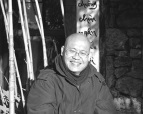
Thay Phap An is a Dharma teacher and senior student of Thich Nhat Hanh, currently living in Plum Village.

